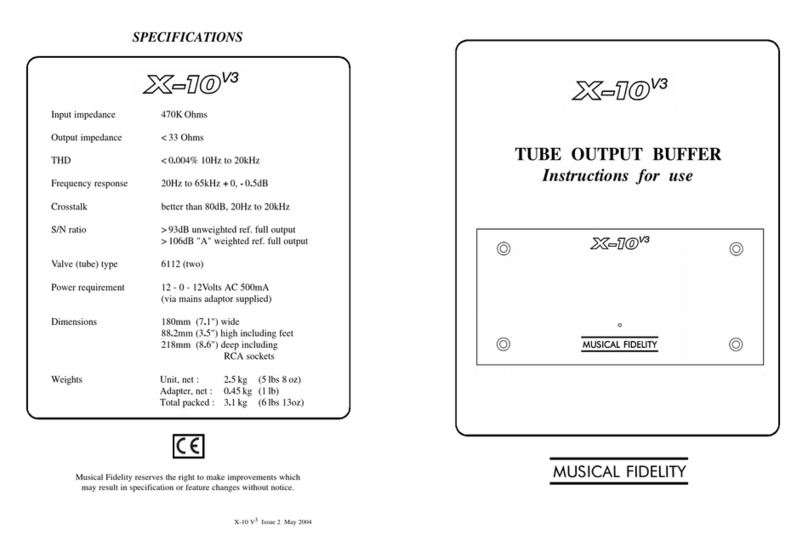7
Operation
Once the M6x DAC unit is correctly wired up, and
plugged into mains, the orange STBY led should be
lit
.
In this mode the M6x DAC is consuming a minimal
amount of power
.
To switch the unit on, press the Power button (1) on
the front of the unit
.
The blue PWR indicator will light
along with the red MUTE indicator
.
After a few
seconds, when it has stabilised, the MUTE function
will switch off and the unit is ready for use
.
Input selection
The M6x DAC has a total of five inputs available.
These are Optical 1 and 2, Coaxial, AES/EBU and
also USB.
When the power cable is inserted into the Mains IEC
socket 19 the Optical 1 input is selected by default.
When the M6x DAC is taken out of sleep mode, it will
default to the last input selected.
From the front panel you can cycle through the inputs
by using the ◄ and ► buttons (5). Pressing ► while
on the USB input will cycle back to Optical 1. Whilst
on Optical 1 the ◄ button will take you to the USB
input again.
The remote control has direct access buttons for
each input. Simply press the appropriate button to
move directly to that input.
When a valid signal is received on the selected input,
an indicator in either group 7, 8or 9will light to show
you the incomming sample rate.
Optical and coaxial inputs
All optical and coaxial inputs are capable of
accepting up to 24 bit 192 kHz PCM stereo data
streams and MQA data streams. The incoming data
sample rate is displayed on the front panel LED’s for
reference.
Note: The indicators 7, 8and 9show the actual
sample rate of the digital data received by the M6x
DAC. Some playback software may have altered this
compared to the original file.
USB Input
The USB input is capable of accepting up to 32 bit
768 kHz PCM, DSD 256 (native DSD 512) data
streams and MQA data streams.
Computer settings for USB
A good quality USB 2.0 cable is required to connect
the unit to the computer. Normal USB standards
stipulate that this should be 5M or less; and we
recommend keeping it as short as possible.
WARNING: Older USB cables are often heavy and
bulky and must be supported to avoid damage to
the USB socket. Any physical damage caused to this
socket will not be covered by warranty.
The computer should now detect the M6x DAC. A
driver installation is only required on Windows.
• Linux kernel 2.6.33 or later (no driver required)
• Apple OS X® 10.6.4 or later (no driver required)
• Windows 10 Creators Edition or later (driver
found on included CD or on Musical Fidelity
website)
For playing native DSD on Windows a driver
installation is required.
Any device that is compliant to the USB Audio Class
2.0 standard should also operate with the M6x
DAC. However Musical Fidelity are unable to
provide support for operation with anything other
than the system listed above.
CD, MP3, WAV, AAC/+, OGG, FLAC, and any other
audio file types played on suitable playback
software will now play through the unit.
Note: This USB input has a high-speed serial data
processor, and by its nature, requires a very high
volume of USB bandwidth. It will benefit greatly
from being the only device connected on its USB
‘bus’. Sharing the same bus with other devices
could cause unwanted artifacts such as dropouts or
temporary loss of signal. This especially includes
the use of the unit on a USB hub/splitter whether
alongside other USB components or not. A direct
connection to the host computer by shortest USB
2.0 lead possible is very much recommended.

































